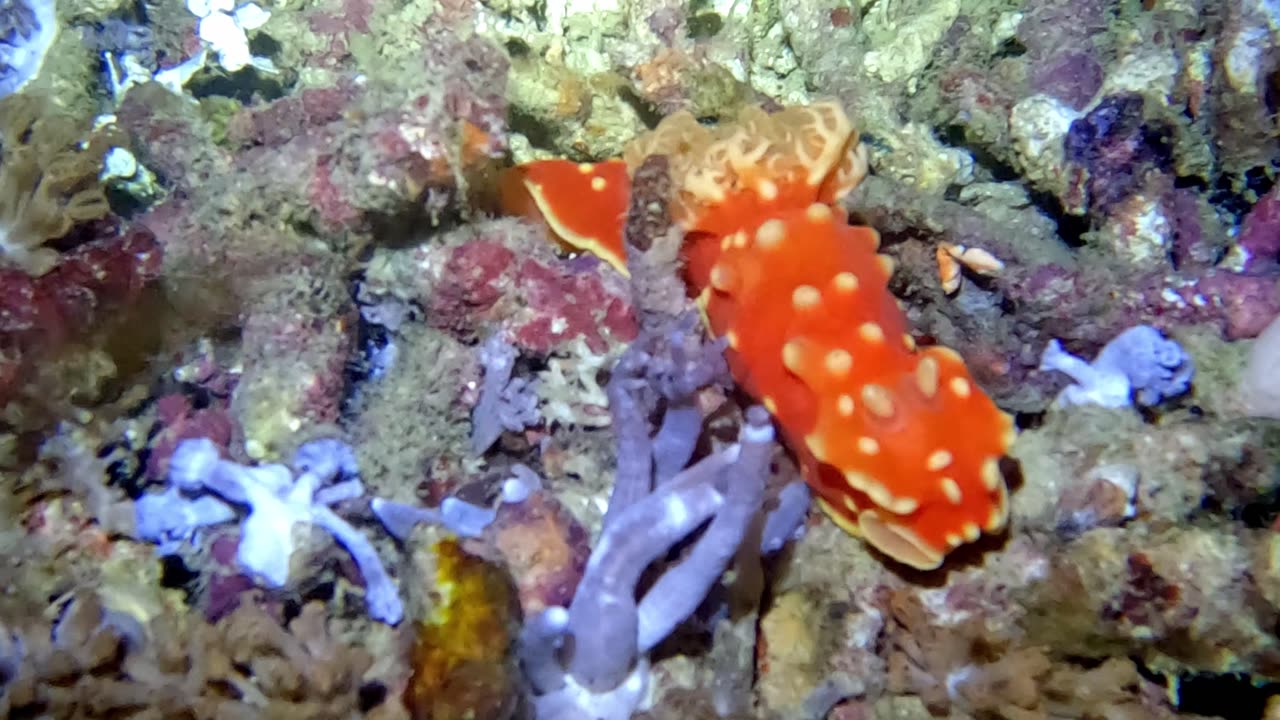Premium Only Content

The beautiful and fascinating strawberry nudibranch
Strawberry nudibranchs, are a species of marine gastropod mollusks. These captivating sea slugs are widely distributed throughout Indo-Pacific coral reefs, where they play a unique role in the marine ecosystem.
Characterized by their vibrant colors and intricate patterns, strawberry nudibranchs are relatively small, measuring around 1 to 2 centimeters in length. Their name is derived from their striking resemblance to strawberries, as their bodies feature shades of red, pink, and orange, often accompanied by white or yellow markings. This vivid coloration serves as a form of camouflage, helping them blend into their coral reef habitats.
The frilly, tassel-like structures on the back of the nudibranch are the gills. These external gills allow them to filter oxygen from the sea water. Nudibranchs are slow moving, can swim or be propelled along either by muscular contraction or by millions of tiny hairs on the bottom of a fleshy "foot". They have a voracious appetite and feed with a rasp like tongue.
Strawberry nudibranchs primarily feed on soft corals. Unlike some other nudibranch species that utilize stinging cells (nematocysts) from their prey for defense, strawberry nudibranchs are known to incorporate these nematocysts into their own tissues. This unique adaptation provides them with a level of protection against potential predators.
These sea slugs have a fascinating reproductive strategy. They are hermaphroditic, meaning each individual possesses both male and female reproductive organs. During mating, two nudibranchs exchange sperm with each other, and later, each one lays a ribbon-like egg mass on the coral substrate. The eggs develop into veliger larvae, eventually settling onto the coral reef and metamorphosing into the adult nudibranch form.
The presence of strawberry nudibranchs in coral reef ecosystems contributes to the overall biodiversity and ecological balance. They play a role in controlling soft coral populations, helping to maintain a healthy coral reef environment.
Scientists continue to study these captivating creatures to better understand their behavior, ecology, and the intricate relationships they have with their surroundings. As coral reefs face numerous threats, including climate change and habitat degradation, the study of species like the strawberry nudibranchs becomes crucial in the conservation efforts aimed at preserving these fragile marine ecosystems.
-
 1:45
1:45
WildCreatures
22 days ago $1.05 earnedGiant manta rays surround scuba divers in Galapagos Islands
3.12K2 -
 3:51:28
3:51:28
I_Came_With_Fire_Podcast
14 hours agoSPECIAL LIVE FIRE w/ Bearded Viking Mead Co
74.8K9 -
 1:28:52
1:28:52
Kim Iversen
12 hours agoUnmasking the Truth: Most Censored Historian On Past Election Meddling, COVID, and Trump
73K66 -
 2:10:00
2:10:00
TheSaltyCracker
10 hours agoNow Lefties Lose Bathroom War ReeEEeE Stream 11-20-24
141K260 -
 1:03:31
1:03:31
Fresh and Fit
11 hours agoWhy Men Need Options To Avoid Falling For This!
115K14 -
 1:26:56
1:26:56
Flyover Conservatives
1 day agoWar Raging, Bank Closing, and Humanoid Robots: It’s Biblical! - Clay Clark | FOC Show
52.7K14 -
 5:32:27
5:32:27
tacetmort3m
1 day ago🔴 LIVE - MY MOST ANTICIPATED GAME IS OUT - STALKER 2 LAUNCH DAY
26.9K -
 1:05:16
1:05:16
Glenn Greenwald
13 hours agoBiden Again Isolates The U.S. To Protect Israel; Will The Trump Admin Be Any Different On Israel? U.S. To Send Ukraine Civilian-Killing Landmines | SYSTEM UPDATE #369
101K87 -
 2:21:27
2:21:27
WeAreChange
12 hours agoPSYOPS Launched To Sabotage Trump's Cabinet! MAGA Fights Back!
62K11 -
 1:25:02
1:25:02
The Officer Tatum
12 hours agoLIVE The View FORCED To Apologize, Laken Riley Verdict, Nancy Mace and MORE OT Show EP 12
75.6K186